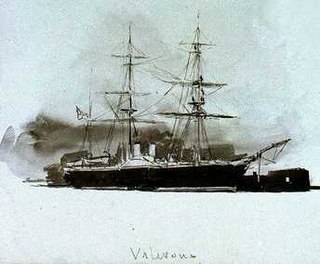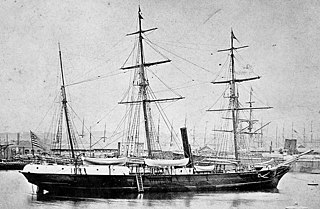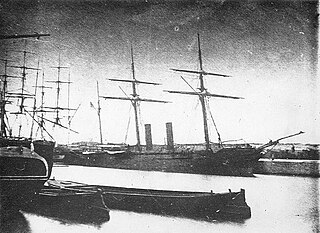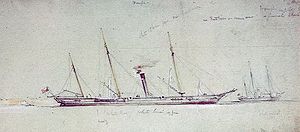
HMS Miranda was a 14-gun wooden screw sloop of the Royal Navy. As part of the 1847 Program, she was designed by John Fincham, Master Shipwright of Portsmouth ,and is considered an improved Rattler, with the design approved on 3 November 1847. She was ordered on 25 April 1847 with the name Grinder from Royal Dockyard, Sheerness. On 3 November 1847, she was reordered as Miranda from Sheerness Dockyard. Launched in 1851, she was completed to see action in the Crimean War. In 1854 she was in the White Sea and participated in the bombardment of the Port of Kola. She then served in the Sea of Azov during 1855. Two of her crew were awarded the Victoria Cross for their bravery. Towards the end of her career she transported troops during the New Zealand Wars. She was reclassified as a corvette by 1862. She was sold for breaking in December 1869.

HMS Valorous was one of two 16-gun, steam-powered Magicienne-class second-class paddle frigates built for the Royal Navy in the 1850s. Commissioned in 1853 she played a small role in the Crimean War of 1854–1855 and was sold for scrap in 1891.

HMS Beagle was a wooden-hulled Arrow-class second-class screw gunvessel launched in 1854 and sold in 1863. She was the third vessel of the Royal Navy to use the name.

The Algerine-class gunboats were a class of six 3-gun wooden gunboats built for the Royal Navy in 1857. A further pair were built in India for the Bombay Marine in 1859.

The Mariner class was a class of six 8-gun gunvessels built for the Royal Navy between 1883 and 1888. Four were built in the Naval Dockard at Devonport, and two elsewhere; the Acorn was built by contract at Jacobs Pill on the Pembroke River, while the Melita was built in the Malta Dockyard, the only substantial ship of the Royal Navy ever to be built in the island.

HMS Surprise was a Vigilant-class gunvessel of the Royal Navy. She was launched at Blackwall Yard, London in 1856 and broken up in Plymouth in 1866.

The Vigilant-class gunvessel of the Royal Navy was an enlarged version of the Arrow-class gunvessel of 1854. Both classes were designed for shallow-water operations in the Baltic and Black Seas during the Crimean War. Fourteen of the class were completed, but were ready too late to take part in that conflict. Cormorant was sunk in action at the Taku Forts, Osprey was wrecked on the coast of Africa in 1867 and the rest were all sold during the 1860s, with Sparrowhawk lasting until 1872.

HMS Mullett was a Royal Navy 5-gun Philomel-class wooden screw gunvessel launched in 1860. She served on the coast of West Africa and on the North America and West Indies Station before being sold in 1872 at Hong Kong for mercantile use. As the sailing ship Formosa she sailed in the Far East before being converted to a magazine in Melbourne.

The Condor-class gunvessel was a class of four Royal Navy composite gunvessels of 3 guns, built between 1876 and 1877. They were all hulked or sold before 1893, giving them an active life of less than 15 years.

HMS Sparrowhawk was a Vigilant-class second-class despatch/gunvessel launched on 9 February 1856 at Limehouse, England and served at various stations in the Far East. By the spring of 1865, her rig was a converted to that of a three-masted barque. She was sold in 1872, converted to a sailing barque in mercantile service, and was later a coal lighter in Australia.

The Philomel-class gunvessel was a class of wooden-hulled screw-driven second-class gunvessels built for the Royal Navy between 1859 and 1867, of which 26 were ordered but only 20 completed. They had a mixed history, with some serving for as little as 5 years, and others surviving into the 1880s. Two of the class were sold and used as Arctic exploration vessels, both eventually being lost in the ice.

HMS Myrmidon was a Cormorant-class gunvessel of the Royal Navy, built at Chatham Dockyard and launched in 1867. She served on the North America and West Indies Station and surveyed parts of the Australian coast before being sold at Hong Kong in 1889.

Intrepid-class gunvessels were a class of six Royal Navy first-class wooden gunvessels built in 1855-56. They were rated as sloops from 1859 to 1862, and were scrapped by 1865. Victor was sold to the Confederate States of America as the raider CSS Rappahannock, but she was interned by the French at Calais and never fulfilled her intended function.

HMS Magicienne was the lead ship of her class of two 16-gun, steam-powered second-class paddle frigates built for the Royal Navy in the 1850s. Commissioned in 1853 she played a small role in the Crimean War of 1854–1855 and was sold for scrap in 1866.
The Gleaner -class gunboat was a class of six gunboats built for the Royal Navy in 1854 for use in the Crimean War.

The Albacore-class gunboat, also known as "Crimean gunboat", was a class of 98 gunboats built for the Royal Navy in 1855 and 1856 for use in the 1853-1856 Crimean War. The design of the class, by W. H. Walker, was approved on 18 April 1855. The first vessels were ordered the same day, and 48 were on order by July; a second batch, which included Surly, were ordered in early October.
The Highflyer-class corvettes were a pair of 21-gun wooden screw corvettes built in the 1850s for the Royal Navy.

The Cormorant-class gunvessels were a class of 4-gun first-class gunvessels built for the Royal Navy in the 1860s. They were somewhat unsuccessful; intended for shore bombardment in shallow water, they exceeded their design draft by 50%. Seven of the 13 ships ordered were suspended, with 3 finished or converted as survey ships and the other 4 cancelled. Racehorse was wrecked after only 4 years, and those ships that were completed as planned had short operational lives, in some cases less than 10 years. The survey vessels lasted longest, with the last ship of the class, Sylvia, being broken up in 1890.

This group of vessels were originally slated to be built to the Sampson designed steam vessel; however, the Admiralty on 9 May 1845, ordered the first pair as First-Class screw sloops to be built from a design of Sir William Symonds, Surveyor of the Navy. This design would become known as the Conflict-class sloop. These would be 10-gun vessels with 400 NHP engines. The second pair of vessels were ordered on 26 March 1846 but after their keels were laid at Pembroke Dockyard, their construction was suspended in September 1846 then cancelled five years later, on 4 April 1851. Both completed ships served in the Baltic during the Crimean war, and Desperate briefly served as a store ship to Edward Augustus Inglefield's Arctic expedition. They had both been broken up by 1865.
HMS Ringdove was a Vigilant-class gunvessel of the Royal Navy. She was launched by J. Samuel White, Cowes in 1856 and broken up in Cowes in 1866.















